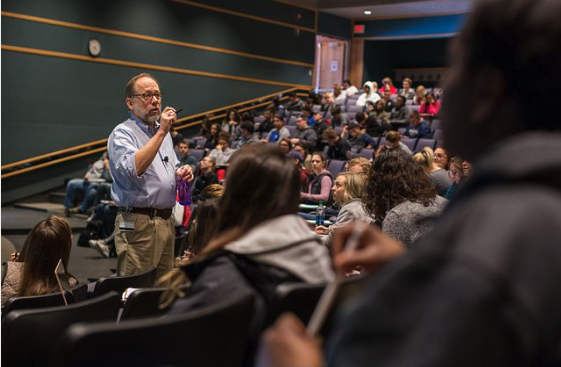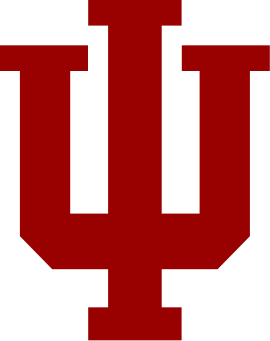Indiana University Lays the Foundation for Active Learning at Scale
1
School-wide agreement providing universal access to faculty and students
690%
Increase in students using Top Hat since school-wide agreement
157%
Increase in faculty using Top Hat since school-wide agreement

The Challenge
Giving faculty the right tools to embrace active learning
Active learning is well known to improve learning outcomes. It encourages exploration, prioritizes the application of knowledge and has been shown to reduce or even eliminate achievement gaps for historically marginalized populations. Little wonder, then, that the Center for Innovative Teaching and Learning at Indiana University Bloomington has made active learning a cornerstone in its faculty development program. “It helps students take more responsibility for their learning and allows the instructor to be much more of a coach,” says Maggie Ricci, Manager of eLearning Services. But even for the most forward-thinking institutions, barriers persist.
While Indiana University had been using clickers from Turning Technologies, they were costly and the functionality was limited. Beyond the issue of affordability, faculty were hesitant to invest time learning other classroom technologies that didn’t have the backing of the institution. Being able to rely on instructional technology consultants for guidance, support and Canvas integration is essential for most instructors. So too is knowing that the tools have been vetted for privacy and security and to ensure an accessible learning experience. For Ricci, the bottom line is simple: “If we’re serious about active learning, we’ve got to give people the right tools.”
“If we’re serious about active learning, we’ve got to give people the right tools.”


The Solution
Removing barriers to student affordability and faculty adoption
For a school committed to promoting evidence-based pedagogy, finding a clicker replacement wasn’t enough. The solution had to be easy to use for faculty and students, affordable for the university, and it had to advance the school’s strategic priorities around expanding online learning options and supporting student success through innovative teaching practices. So the school broadened its efforts to include a pilot with Top Hat. “Of course, whenever we’re piloting a tool, we’re also piloting the company,” says Ricci. “Are they interested in engaging with us? With faculty? What about those of us who are responsible for how all this works?”
The ability to take attendance automatically and improve in-class engagement with polls and quizzes offered compelling reasons for change. Additional points of value included providing students with interactive readings and assignments and giving faculty the flexibility to teach online, in person and in a hybrid format. Every interaction—attendance, quiz result, homework assignment—is also tracked, allowing instructors to see in real time how students are doing and to adjust their teaching and interventions accordingly.
Impressed with the support the Top Hat team provided throughout the pilot, Indiana University decided to start with a student-pay model. But it became clear that to really drive adoption, they needed to invest in a school-wide licensing agreement to remove the cost barrier to students. A year later, when a new agreement was signed giving every faculty member and student free access to the platform, adoption really began to take off.
“I was thrilled when we signed with Top Hat, because I knew I didn’t have to worry about students who were economically disadvantaged being able to afford access,” says Valerie O’Loughlin, Assistant Director of Undergraduate Medical Education at Indiana University School of Medicine. “A school-wide licensing agreement also provides an additional layer of confidence because I know that our instructional consultants are well-versed in the program.”
The licensing agreement is about more than just removing the cost to students. Ensuring an accessible learning experience is also critical. With Top Hat, students can use any device—mobile phone, laptop, tablet—to access the platform. FERPA compliant with respect to data privacy, Top Hat’s products and services are also designed to meet internationally recognized standards for web accessibility, an important distinction for many faculty. “Accessibility is really important to me,” says Tehanee Ratwatte, a lecturer at Indiana’s Kelley School of Business. “I’ve worked with students with seen and unseen disabilities and other platforms we’ve tried didn’t feel like they’d given enough thought to that.”
The Results
Making every student an active participant in the learning process
When it comes to change and transformation, a key advantage of the licensing agreement has meant that instructors are more willing (and able) to experiment with the technology. Jennifer Turrentine, an instructional consultant at Indiana University’s Center for Innovative Teaching and Learning, says instructors are more likely to try it in their classes given there’s no cost to students. “It really lets them ramp into it more slowly and to do things at their own pace,” she says.
Ratwatte likes the effect Top Hat has had on increasing student engagement. This includes giving students the option to respond anonymously to polls and discussion questions. “Having the ability to engage students who might be reluctant to do so for a variety of reasons has been really good,” she says.
Better engagement is already paying dividends in terms of student outcomes for Valerie O’Loughlin, who uses a modified flipped classroom approach for her Basic Human Anatomy class of roughly 480 students. O’Loughlin has put a special focus on using in-class questions to ensure students are better prepared for exams. In her analysis, students who came to class and participated using Top Hat achieved an average lecture exam score of 79.4 percent compared to 46.7 percent for those who did not participate.
While the university is keen to continue growing adoption, O’Loughlin’s results are a good indication of what’s possible. “We’re preaching active learning and we’re now putting our money where our mouth is,” says Ricci. “I am proud that a lot of instructors who’ve never used a student response system have stepped up and started using it.”









